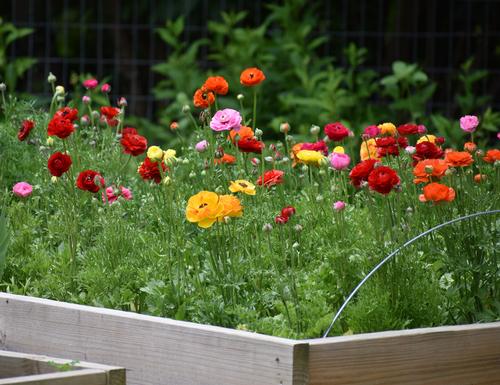Ranunculus, known for their vibrant colours and delicate petals, can be paired with various flowers to create stunning arrangements. Citrus-coloured tulips and daffodils can add a pop of colour to a bouquet, while light pink roses and peonies can bring softness to the display.
To add texture, try pairing ranunculus with greenery like eucalyptus or ferns. Whether creating a romantic bouquet or a whimsical arrangement, the possibilities are endless when it comes to combining these beautiful flowers.
Important items to pair with Ranunculus:
- Tulips
- Daffodils
- Roses
- Peonies
- Eucalyptus
- Ferns
Because of their smaller size and unique texture, ranunculus pair well with almost any flower or greenery, such as peonies or garden roses, anemones, tulips, dahlias, stock, astilbe, and soft, drapey greens like the ferns I used here.
How Do You Arrange Ranunculus?
Fill the vase with warm water and add flower food after you’ve chosen it. Place a ranunculus stem on one side of the vase and another on the opposite side, adding greenery and other flowers if you want to keep the arrangement balanced.
Ranunculus is a beautiful flower with multiple petals that come in different colors. When arranging ranunculus, it is important to consider the length of the stem, the size of the vase, and the aesthetic you want to achieve.
Start by cutting the stems at an angle and removing any leaves that will fall below the water line. Arrange the flowers by placing the largest blooms in the center and working outwards with smaller ones. Add greenery to fill gaps and create a fuller look.
“Arrange the flowers by placing the largest blooms in the center and working outwards with smaller ones.”
Important items to consider when arranging Ranunculus:
– Stem length
– Vase size
– Aesthetic
– Removing leaves below water line
– Placement of flowers
– Adding greenery
– Water changing routine
How Much Space Do You Need Between Ranunculus?
Ranunculus corms are established 9 in (23 cm) separated at a profundity of 2-3 in (5-7.6 cm), with 4 columns for every bed. Plant corms with the “octopus appendages” pointing down. During cold stretches, when temps plunge underneath freezing, cover the plants with a layer of ice material.
When planting ranunculus, it is important to leave enough space between each plant to allow for proper growth.
Ranunculus are beautiful flowers that create stunning displays when planted in gardens or pots. To ensure your ranunculus flowers flourish, it’s essential to space them out properly. Here are some tips to consider when planting ranunculus:
– Space ranunculus bulbs about 4-6 inches apart from each other.
– Plant bulbs at a depth of around 2 inches to protect them from the elements.
– Choose a location with well-draining soil and full sun exposure for optimal growth.
Proper spacing between ranunculus bulbs can help prevent overcrowding, which can lead to stunted growth or diseases. So, take the time to properly space out your ranunculus bulbs, and you’ll be rewarded with a beautiful, blooming garden.
Not:In addition to the information we have provided in our article on
ranunculus garden ideas images, you can access the wikipedia link here, which is another important source on the subject.
What Can I Plant Next To Ranunculus?
Companion Plants Other cool-season flowers like African daisies, calendula, candytuft, Chinese forget-me-nots, Iceland Poppies, linaria, pansies, snapdragons, and sweet peas are good companion plants for ranunculus.
Ranunculus, the bright and colorful flowers, make a great addition to any garden. But what can you plant next to them? According to gardening experts, some plants that are suitable to grow alongside ranunculus include:
– Pansies and violas
– Snapdragons
– Lobelia
– Calendula
– Alyssum
These plants have similar growing conditions and will complement the beauty of the ranunculus. Moreover, they will create a harmonious and diverse environment in your garden.
So, if you want to enhance the beauty of your ranunculus garden bed, include these colorful companions to create a perfectly balanced and stunning display!
Where Is The Best Place To Plant Ranunculus?
In USDA zones 8 to 11, ranunculus can be grown in full sun to partial shade in moist, well-drained soil. In colder zones, they can be grown as annuals.
Ranunculus is a beautiful flower that can be planted in various areas of your garden. However, knowing where to plant them can make all the difference. These flowers prefer well-draining soil, so finding an area with proper drainage is essential.
A location with partial sunlight and shade will also provide the best growing conditions. Planting Ranunculus in areas with strong winds can break their delicate stems, so it’s best to plant them in a sheltered area.
Proper drainage, partial sunlight and shade, and shelter from strong winds are key factors for successful Ranunculus planting.
Key tips for planting Ranunculus:
– Well-draining soil is necessary
– Partial sunlight and shade
– Protection from strong winds
Where Should I Plant Ranunculus?
In USDA zones 8 to 11, ranunculus can be grown in full sun to partial shade in moist, well-drained soil. In colder zones, they can be grown as annuals.
Ranunculus prefers a sunny location with well-draining soil.
Ranunculus is a beautiful flowering plant known for its bright and bold colors. When planting ranunculus, it’s important to choose the right location for optimal growth. The ideal location for this plant is a well-draining soil that gets plenty of sun.
A spot that receives at least six hours of full sun is perfect for ranunculus. It’s also essential to consider the climate and temperature in your area. Be sure to plant ranunculus bulbs in the fall for a stunning spring bloom. With the right location and care, ranunculus will thrive and brighten up any garden or landscape.
FAQ – Ranunculus garden ideas images
What are some ideas for a ranunculus garden?
Plant in mass, mix colors, use as borders.
Do ranunculus gardens need full sun?
Yes, 6-8 hours of direct sunlight is best.
